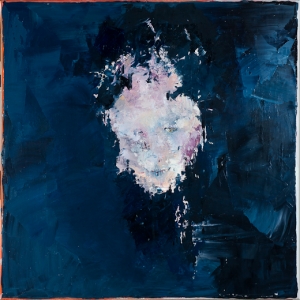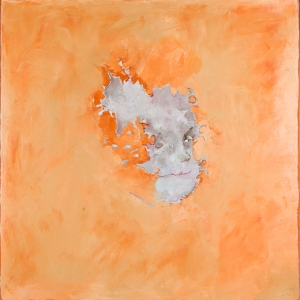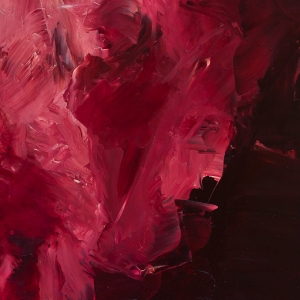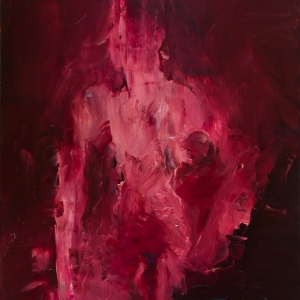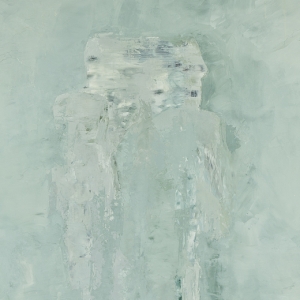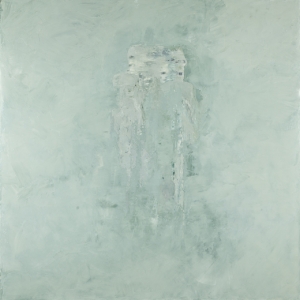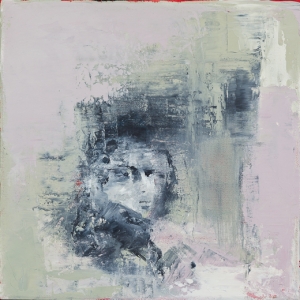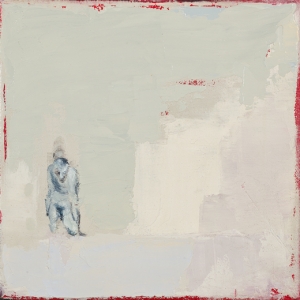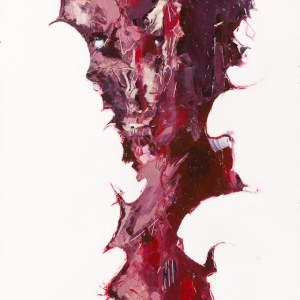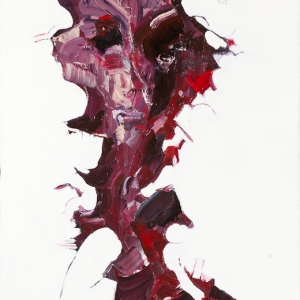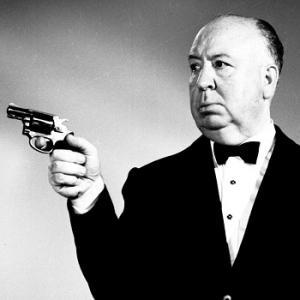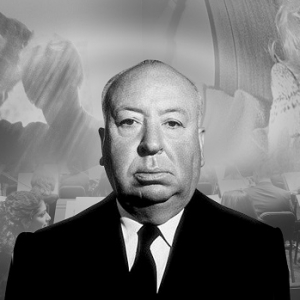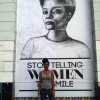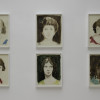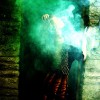JM: Where do we start?
MM: I think maybe we start at the beginning, wherever the beginning is. Where did you begin?
JM: Where did I begin? My dad was an oil painter when he was younger, so there was always a big wooden box of oil paints at home. I started dabbling with them at a very young age, just painting portraits mostly. Then my dad would buy them off me!
MM: Who did you paint, family members?
JM: No! My dad’s idols, John Lennon, Charlie Chaplin, Muhammad Ali. Then I got into dancing and wanting to be a performer, so when I left school I went to dance college. I walked out of six form: I was a punk in a Catholic school, and they were always giving me a hard time.
MM: Punk in your mind, or punk in your appearance?
JM: It was more to do with what I looked like, I’m not sure what that was all about… attention seeking perhaps… I’m not sure what was going on in my head.
MM: So did they kick you out of school?
JM: No they just irritated me (laughs). The Sixth Form house proposed more freedom from uniform and uniformity. My dad was deputy-head in a primary school nearby; he went to see them once and told them to concentrate on what was in my head not on it. They were cross that my hair was spiky. I left by writing a note on the blackboard saying “I’ve left,” and signed it Jennifer Mills. I was out of there! I went off to dance college but that was a struggle, being 17 and feeling like I didn’t fit into the clique. I left at 18 and started studying art at the same time as working in bars and partying a lot. Then was pregnant by twenty, oops!
MM: It’s not so oops?
JM: I’m glad I did, because by thirty I had cancer and now I can’t have children. And Sonny… if you met him, you wouldn’t forget him. From the minute I laid eyes on him I knew I would absolutely die for him.
MM: I know that feeling. I also know it’s difficult dealing with the stereotypes of having a child at a young age, it’s all too easy for people to categorize you a certain way.
JM: Yes, there are a lot of things that come into play, and a lot of fear. People are comfortable with structure and rules; of course you have to have a bit of that, but some people are not too good with rules and go off the rails as a teenager (laughs). Parents – they have a lot to answer for. Someone once asked me, “do you find your work a release?” I immediately thought “no”. I struggle with that idea: work isn’t therapy, it’s universal property. I’m very interested in the idea that there is an undercurrent of a strange ‘Other’ going on, all of the time.
MM: In life?
JM: In society. The unseen. Humans are so complex mentally, there are a lot of ingredients that go into making a piece before it’s distilled into an image on a canvas. A lot of stuff, a real disquiet in society, bubbling all the time. We are not always dealing with the honest things.
MM: For me it’s like theater: when we see it on the stage we know it’s a production. It’s staged, and we are comfortable with the metaphor. Yet the whole thing in life is going on the entire time. When you’re just working in theater it becomes easier to take that as microcosmic for the greater scheme of things.
JM: Yes. It was bizarre yesterday… the show i’m working on Top Hat is set in the 30’s, it’s really candy floss and lovely, very gentle. Ginger Rodgers and Fred Astaire, you know, all feather dress and fantasy. I think I’ve needed a bit of candy floss this year.
MM: A veneer?
JM: Yes and it’s been beautiful, though I am a completely different person from here to there!
MM: Who are you there? What’s your role?
JM: I think they’ve decided to see me as this fluffy character, this blonde thing who is scatty in an endearing way, parking my little birdies outside. That’s quite a nice way to see me I suppose, in the clouds, with the birds…
MM: But how do you see you? Who is Jennifer the artist? Who is she? Who is this role?
JM: I’d like other people to tell me that I think.
MM: Difficult to define yourself?
JM: Maybe!
MM: Can you define your art?
JM: (We laugh). No, that’s for someone else to do. Someone who is more articulate than me. In terms of this dizziness, I think those that are close to me know that this ‘scatty-ness’ is because I’m so distracted, analyzing all of the time, thinking about a lot. Of course I’m distracted. It goes back to what you were saying about theater. We’re all busy playing our part every day, it’s just acting.
MM: There’s always censorship, censoring ourselves.
JM: But we censor the wrong things! Take for instance the character of Keith in Mike Leigh’s Nuts in May. Or the tension between his characters in Abigail’s party. They all blow their cover. I also seem to be drawn to loner protagonists depicted in film, for example Travis Perkins in Scorsese’s Taxi Driver. He watches the city as an outsider looking in, without any control of the things that trouble him. We are all individual. We are all alone, even more so if we’re all putting the act on. The more we repress, the lonelier we are. I think that’s why some people may look at my work and have no idea why it is that they know that place, why it is they can relate to it – because it’s coming from that same place, it’s been distilled into an image that represents that intense, ubiquitous feeling. But I prefer other people to talk about my work otherwise i’m pinning it down.
MM: Previously you spoke about Film Noir and Frances Bacon being amongst your influences…
JM: Yes, it’s not so much the images of Francis Bacon’s work, it’s more the process. It’s the truth he’s dealing with… a truth. He’s getting to the intense feeling of ‘the something’ and dealing with it, but he also knows when it’s not right. I’m not sure that’s right (Jennifer points to a painting she’s been working on). When that happens, an artist scraps it and starts again. Communicating with color, the stuff of paint, is a two way thing, the paint’s in charge a lot too.
MM: The paint dictates the relationship you have with the canvas?
JM: It’s just a lovely thing to do, to interact with this stuff (points to paint) to make the colors and the way it behaves on there.
MM: How much control do you have?
JM: Well I’m making it, like a medium. There’s just a rightness to where each bit should be and that’s like a piece of music, a composition that should just be a particular way. I use palette knifes as well, I like the paintings to look like they’ve happened, I don’t want brush work to be seen, I want them to be events. Sonny said “they’re like a performance, if you look at them for long enough all sorts start happening, they perform.”
MM: You mentioned that you don’t always give your paintings titles.
JM: I don’t always like to title them, it pins them down and they don’t always need it, but I did title one Henry, from David Lynch’s film Eraserhead.
MM: An obvious film influence.
JM: Yes, I like Henry, he’s lost in this funny little world where even walking is awkward. The only place he’s really comfortable is when he’s in the fantasy world. When I first watched Eraserhead in my twenty’s I was completely drawn in, I felt like I knew what it was like to be Henry. I felt like I knew that space in between. It was all so surreal and I didn’t need to understand all of the narrative, I just related to him on a deep and personal level. At the time I thought it was the most amazing film ever: the imagery, the use of light. Around the same time I saw Twin Peaks ‘Fire Walk With Me’, and you know the guy in it that talks backwards? Again, I thought “I can really relate to all this.” I’ve never seen the series though, like seeing bits of a painting but never the whole thing.
MM: It’s interesting you say that because I get the feeling that I have to see all of your paintings to get the whole picture, because each one is saying something in relation to the other. There’s a recurring sense of a something emerging through the shadows, through a darkness; they’re very staged. When did you graduate from St Martins?
JM: In 2002, but it was a bit hickety-pickety at the beginning, I got cancer during my time there and went off to deal with that in between. In my third year I came into contact with Mike Thorpe who is one of The London Group of painters, and I’ll always be grateful to him. I’d been trying to find my way to communicate, which is essentially why you’re an arts student, because you don’t already know. I was dabbling with film and photography which was nice, but none of the tutors were really getting excited about it. Then I met Mike and showed him these (points to earlier paintings). I was very apologetic about them and told him that I knew they were corny, saying “they’re just this,” and “just that.” But I really identify with Hitchcock. I’m also continuously apologizing, doubting myself, thinking I wasn’t smart enough, and comparing myself to other students. This was written by Mike Thorp before I got to the end of the degree: “Jen has had some difficulty in identifying a way of making work that deals with the subjective personal content she wants to talk about.”
JM: He thought it was very personal and would look at some of my paintings and tell me I was getting close but needed to get naked. “Jenny wants to deal with the everyday to find significance and menace in the insignificant, to exploit understatement rather than the dramatic, though this is repositioning from the earlier intentions to create paranoid spaces reinforced by her thesis research on Film Noir. I suggest that she reads Pierre Bouleau/Thomas Narcejac’s D’entre les Morts. The unmodified Film Noir language she was using earlier was too prescriptive, pre-formed and thus insensitive to the innuendo and subtlety she wants to deal with. She almost certainly needs to work from dark to light both practically and metaphorically, which would allow the content to be found and merge from the process, allowing for moments of recognition.”
JM: “She has made a number of small evocative paintings and drawings, the most interesting of which was a painting she made last year and discarded. It depicts a head looking out from the canvas, one eye sighted and the other apparently blind. The head is compressed by two white forms on either side of it, that may be either spaces or presences, there are subliminal suggestions of eyes, it comes closer to the way she talks about her intentions than anything else she has produced does. She should look on it as a talisman rather than discarding it. Jenny has had an uneven college term, not as a consequence of lack of effort but through a genuine search for a language that will enable her to talk about deeply personal experiences and perceptions. I am optimistic that she will find a way of doing this.”
MM: Do you think you have?
JM: Hmmm… I don’t know!

